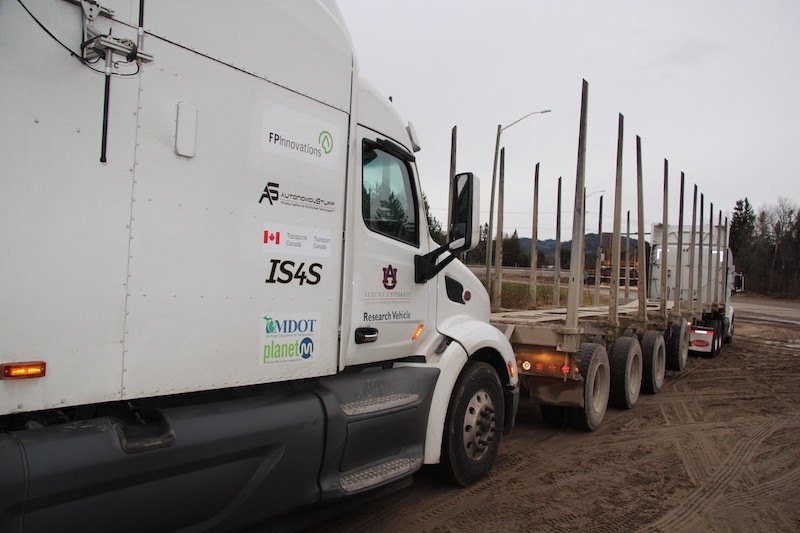
Features
Harvesting
Transportation
FPInnovations and partners successfully test forestry truck platooning
Nov. 7, 2018 – FPInnovations and its partners took truck platooning research a giant step further this week and earned a spot in history by successfully road testing the emerging technology in the deep forests of Quebec in the first trial of its kind in Canada.
November 7, 2018 By FPInnovations
 Photo and video courtesy FPInnovations
Photo and video courtesy FPInnovations The trial took place in Rivière-aux-Rats, Quebec and signals the beginning of a transformation of the forest transportation industry on a scale not seen in decades. It could also solve the chronic issue of a skilled-driver shortage that’s plagued the industry for years and shows no signs of abating. The tests involved two platooned trucks hauling logging trailers on resource roads between a Resolute Forest Products saw mill and the company’s logging site 75 km away. Drivers were at the wheels of the trucks but in the future, only the lead truck will have a driver and the following trucks will be fully automated.
“These tests are a major accomplishment,” says FPInnovations lead scientist, Francis Charette. “To the best of our knowledge, no one has tested platooning in a forest environment before. As a respected forestry R&D organization, FPInnovations is ideally positioned to bring together specialized research organizations and commercial industries to further our common goal of introducing platooning on forest roads.”
The trial is part of a joint research project in collaboration with Transport Canada, Alabama’s Auburn University, and Resolute Forest Products. Earlier this week, platooning was also successfully tested by FPInnovations’ PIT Group, Transport Canada, and Auburn University on public highways in Quebec. The platooning technology was developed by Auburn University’s department of mechanical engineering.
“There are switchbacks, steep slopes and dense forests that impact the communications systems between trucks,” says FPInnovations engineer, Édouard Proust. “We expected that and we’re working on the technology to solve the issues.”
Until yesterday, there was no data available on how a platooning system would work under the thick canopy of a forest. “Now we know what the technology gaps are, we’re addressing them,” says Auburn University mechanical engineering professor and director of the GPS and Vehicle Dynamics Laboratory, David Bevly. “Our platooning technology has already been successfully implemented on highways and it can include forestry operations.”
Truck platooning is an emerging vehicle technology in which trucks are linked by a computer system that maintains the desired distance between trucks, as well as controls acceleration and braking, reacting faster than a driver typically can. Platooning uses a dedicated short-range radio communications (DSRC) protocol approved for communications at high-speeds, as well as a GPS system and radar technology. Highway platooning is already legal in several U.S. states, including Tennessee and Georgia. However, platooning is only in the testing phase in Canada.
“We’re very glad to be a part of the tests,” says Resolute Forest Products director of forestry operations, Jonathan Perron. “The forestry industry has to be innovative to compete globally and the concept of automated platooned trucks following one lead truck driver can help us improve our efficiency despite a labour shortage that’s affecting our industry across the country. We also believe that this type of technology will help us attract a new generation of forestry workers.”
FPInnovations will build upon the results of today’s tests to continue pioneering forestry truck platooning research in Canada.
For more information, please contact Édouard Proust at edouard.proust@fpinnovations.ca.
Print this page